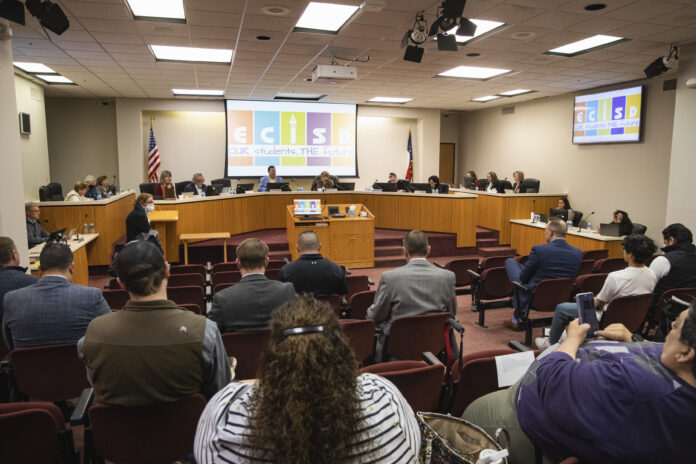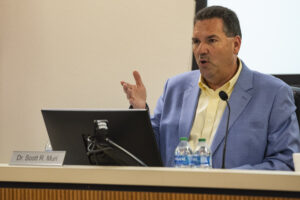
The Ector County ISD Board of Trustees approved 100 acres of district-owned land at Yukon Avenue and Faudree Road as the location for a new high school.
But it is all contingent on the passage of a May bond election.
The motion was made Tuesday by trustee Chris Stanley and seconded by Donna Smith. The high school would be built there if the high school proposition of a $398,255,000 bond passes.
Proposition B, for $183,000,000, would go for a new comprehensive high school. The high school would have a 2,500-2,800 student capacity and enclose an estimated 400,000 square feet. It would include furniture, fixtures, and equipment.
Proposition A for $215,255,000 would include maintenance and life-cycle repairs/replacement for school district buildings ($130,255,000); construction of a new Career & Technical Education Center for $70 million; and classroom technology upgrades for $15 million.
The high school site is in northeast Odessa and is across from Parks Bell Ranch, Superintendent Scott Muri said.
The land was purchased in September 2015 for a little more than $2 million.
Muri said there are currently 5,000 families living in Parks Bell Ranch. Eventually, the high school would be surrounded by the Parks Bell Ranch development.
Executive Director of District Operations Cortney Smith said high school students are projected to live in the northeast part of the district.
Board member Delma Abalos said they know Odessa High School is growing and is now larger than Permian High School.
“What we need to clarify is that we have land that is already paid for. That doesn’t mean we don’t need another high school; we do. I want to make sure people understand we know there’s growth in West Odessa and we need another high school,” Abalos said.

Muri said the challenge from a bond perspective is the “tolerance level” of the community. The community was clear the bond had to be under $400 million.
It is recommended that a high school be built on 75 to 100 acres. Muri said ECISD doesn’t own any other vacant property that size.
The projected cost is $183 million. The purchase of land was not built into the high school cost, but it was for the Career and Technical Center.
Muri said 40 to 50 acres would be needed for a CTE center.
He said it takes about two years to build a high school. If the bond passes, the district would start selecting architects and engineers. They would also have to sell the bonds.
Summer 2023 would be the first time a shovel would be put in the ground and ECISD would expect to open in summer 2025.
The ECISD website details district leaders anticipate the bond would create a tax rate increase of 15 cents and, for a home with a taxable value of $100,000, would equate to a tax increase of about $12 per month.
There would be no tax increase on residence homesteads for taxpayers 65 and older, as state law dictates that the tax rate and the amount paid on a residence are frozen when that person turns 65 years old, applies for the exemption and is approved by the Ector County Appraisal District. ECISD gives local taxpayers a 20% Homestead Exemption, which is the maximum allowed by law.
The board also:
Heard a report on Schools of Choice. The district currently has 13 Choice Schools; nine of those are full choice (they have no school attendance zones) and four are a hybrid neighborhood/choice campus, the board recap detailed.
About 4,500 students, or 15% of ECISD’s student body attends these schools. During this review, ECISD asked parents and community to offer suggestions for future Choice School programs/themes. A couple of the key elements of the survey responses: the community sees technology programs, preparing kids for the future, and project-based learning as important. Parents also want to see more options for middle school students and high school students.
Several projects already in the works will address these concerns — a partnership that will bring the UTPB STEM Academy to ECISD, an International Baccalaureate Middle Years Program, and a project-based learning model. Long term opportunities under consideration are: shifting the program focus at low-interest elementary schools, launching a fellowship or training program for leaders to assist with the design of future choice experiences and then lead those programs, and to possibly expand Austin Montessori to PK-8.
Received an update on the Gifted and Talented program. District leaders formed an advisory committee of parents, teachers, G/T teachers, principals and administrators; surveyed other school districts, surveyed ECISD parents, and surveyed ECISD teachers.
The committee found 24 of 25 school districts surveyed provide G/T services through inclusion (daily classroom) and partial-day pull-outs (average 100 minutes per week); teachers at all levels understand the importance of differentiating instruction for G/T students and they need more opportunities to work with certified G/T staff and need more information on recognizing and meeting the needs of gifted students, the recap said.
Parents want gifted students to be given chances to work with other gifted students, do not see that gifted students are provided learning experiences different from other students, and would like to attend parent meetings to learn more about giftedness.
The Advanced Academics Department is redesigning GT services with more professional learning, strong curriculum, more family and community involvement work. In the classroom, GT services will look this way: Kindergarten-2nd grade, in an inclusion setting (supported by a certified specialist); 3-5 pull-out (for two-hours per week); middle school students will be served in their Honors classes (supported by a certified specialist); high school students will be served in Honors, AP, IB and Career & Technical Education classes (supported by a certified specialist).
Reviewed winter 2022 MAP Assessment scores. MAP stands for Measure of Academic Progress.
These assessments, which are given three times per year, measure what students know and what they’re ready to learn next. MAP Growth measures performance — whether a student performs on, above, or below grade level over time.
This report compares to the report from one year ago (winter 2021).
In reading, the recap said, growth was seen apparent in nearly all grade levels with kindergarten, 3rd grade and 6th grade all hitting or surpassing projected gains.
In math, it said, results are similar to kindergarten, 2nd, 3rd, 4th, and 5th grades meeting or exceeding projected gains. A few areas fell below expectations; however, student achievement is growing in both reading and math across grade levels — especially in kindergarten, where children are benefiting from the full-day kindergarten program implemented last year.
The data also show a very clear picture that regular school attendance directly correlates to higher academic achievement. In a look at subgroups of students, the largest growth took place among Gifted/Talented students. Growth in math is more rapid than reading among all subgroups. ECISD uses MAP assessments in kindergarten through 8th grade reading and math; English I and II Language, and Algebra I. More areas will be added. MAP growth is one of the measurements the school board uses as an Indicator of Success, the recap said.
Reviewed the renewal plan for ECISD’s District of Innovation plan. ECISD originally applied for, and received, District of Innovation (DOI) status in 2017. The current DOI committee used the strategic plan, finalized in 2019, and indicators of success to keep the plan focused on district priorities.
The DOI committee consisted of 22 people including teachers, parents, and one community member. The five-year plan will be presented again to trustees at next week’s meeting for approval.



